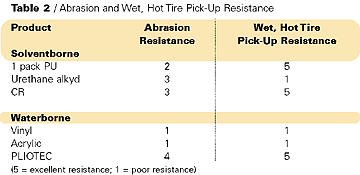
Eliokem (formerly Specialty Chemicals business of The Goodyear Tire & Rubber Co.) is a global specialty resin producer, offering start-to-finish service for niche coatings applications, particularly on concrete surfaces, from initial product conception to final paint product launch and beyond. Our tailored resins for specialized applications, together with our knowledge of the markets and its specific requirements, are the best ingredients for a successful coating. This article examines concrete floor coatings.

Waterborne Floor Coatings Advances
Floor coatings were once considered primarily the domain of professional applicators. The coatings were mainly two-component epoxies and polyurethanes designed for heavy-duty industrial applications such as factory floors, warehouses, and chemical plants. In recent years, there has been a do-it-yourself (DIY) market trend for paint applications to concrete floors, for the following reasons.- To seal the surface and prevent dusting of the concrete
- To make the surface easier to clean, and to keep it clean
- To protect the concrete against aggressive agents such as acids, alkalis, oils, etc.
- For decoration
While there are a number of single-pack floor paints on the market, including solventborne chlorinated rubber, the offering of waterborne garage floor coatings has been increasing over the past few years. However, even though these coatings are extremely easy to use, most were still deficient in terms of hot tire pick-up, tire marking and chemical resistance.
Despite being in a domestic environment, a coated concrete floor should have a high performance level. The coating needs to dry fast and develop a hard protective film that will provide the concrete with resistance to abrasion from foot and light traffic, resistance to chemicals such as automotive fluids (oils, hydraulic fluids, window washer fluid, antifreeze, etc.) and, perhaps most importantly, resistance to hot tire pick-up. Hot tire pick-up occurs when a coating loses adhesion as a result of a hot tire being parked on the surface and warming the coating. The problem is amplified if the hot tire is also wet.
Waterborne floor coatings are moving from the garage to other parts of the house as paint companies expand their product offerings and try to differentiate their products from the competition. Application of waterborne floor coatings in areas such as laundry rooms, youth playrooms and basement floors expands the usefulness of the coating product and also increases the required properties for these coatings. Chemical resistance must now include, besides the typical garage products, various types of household detergents, and the coatings need to resist tough products such as coffee, soft drinks and ketchup. Using the coating for basement floors makes efflorescence resistance a major issue for the coating because it is usually applied and sustained in a wet and sometimes humid environment. When used as an interior coating, the aesthetics of the coating is also a major concern. That is why interior coatings are offered in a variety of colors and finishes ranging from matte finishes to high gloss.
While formulators are striving to make waterborne coatings more versatile, VOC regulations are changing, thus providing an additional challenge to floor coating manufacturers. In California, maximum VOC levels are planned to be lowered from 450g/l down to 100g/l by 2003. The goal is a coating with a low VOC that still performs well, has chemical resistance, and meets the industry needs.
These new requirements, and the need to create competitive advantages for coating manufacturers, have forced resin suppliers to make the following improvements.
- Develop new waterborne resins that could improve the coating properties and provide the paint industry with a
high-performance waterborne technology that performs as well as current single-pack solventborne floor coatings.
- Offer waterborne latices that can be formulated at low VOC levels while maintaining high-quality performance and resistance to chemicals.
- Design new testing procedures that better duplicate the exposure of floor coatings to exterior aggressions and give the coatings manufacturers the confidence that their product will perform well in the real environment and minimize customer complaints.

Resins Deliver Durability in Floor Coatings
Pliotec(r) resins are specialty styrene acrylic latex and acrylate copolymers that have been carefully designed to answer the floor coating requirements. The monomer composition has been optimized to provide the necessary hardness and resistance to a range of Pliotec resins produced by an innovative and creative polymerization technology. This creativity results in new polymers of varying chemistries and differentiated properties. This technology results in an emulsion polymer (dispersion) with good resistance to blushing (whitening) and to softening in contact with water, contributing to its high performance in the harsh conditions often demanded of floor coatings, that ordinary latexes are unable to meet.New grades of the resins have been developed to adjust to the industry changes in requirements and to fill more specific needs. A large choice of resins is available; formulators can choose resins based on the end use of the coating, the VOC legislation or the desirable surface finish.
Thanks to their inherent chemical structure, Pliotec resins provide excellent alkali resistance necessary for application to new concrete surfaces; they also show good general chemical resistance to withstand spills of common fluids, particularly automotive and household fluids. The resins offer excellent resistance to efflorescence and have been used for years in difficult environments providing an excellent barrier to humidity. For difficult environments, hard resins are preferred because they give a hard coating film. They are also favored when a high-gloss finish is required or in a dusty environment where dirt pick-up is an issue. Hard films are required for good abrasion resistance and also for resistance to wet, hot tires. Softer resins will be preferred for application on softer substrates, higher impact resistance, and also formulating at lower VOC levels.
The tables summarize the results of a comparison of a floor coating based on Pliotec with various commercial solvent- and
waterborne floor coatings from the North American and European market. In total, around 20 commercial products were tested;
the results are the average of each general class of product.

Conclusion
The results show that Pliotec resin-based concrete floor coatings have good performance in terms of the key properties demanded of floor coatings: resistance to abrasion, chemicals and wet, hot tire pick-up for domestic and light industrial usage. It compares favorably with solventborne, single-pack coatings, and is better than currently available waterborne products on the market.Pliotec resin-based floor coatings demonstrate an excellent compromise in terms of cost/performance in comparison to commercially available, mono-component products, and offer the ease of application, fast drying, and rapid return to service (24-48 hours) associated with waterborne coatings. Furthermore, it is low in odor, a factor important for indoor application in confined areas such as a garage.
In the United States and Europe, Pliotec resin technology is continuously being developed to bring new products and applications to the market, and also to accommodate changes in market requirements, such as those brought about by legislation or national agreements.
For more information on resins, visit www.eliokem.com.





